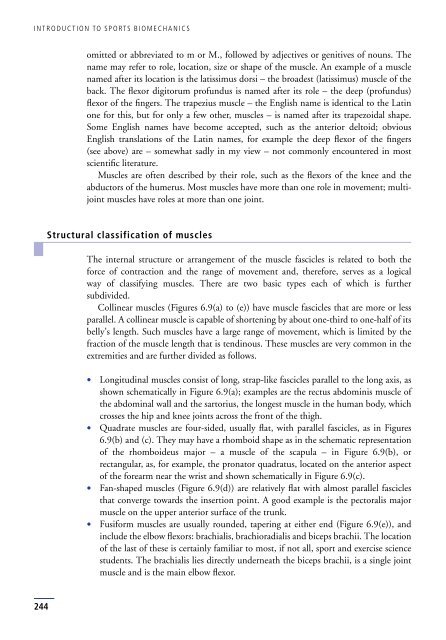Introduction to Sports Biomechanics: Analysing Human Movement ...
Introduction to Sports Biomechanics: Analysing Human Movement ...
Introduction to Sports Biomechanics: Analysing Human Movement ...
You also want an ePaper? Increase the reach of your titles
YUMPU automatically turns print PDFs into web optimized ePapers that Google loves.
INTRODUCTION TO SPORTS BIOMECHANICS<br />
244<br />
omitted or abbreviated <strong>to</strong> m or M., followed by adjectives or genitives of nouns. The<br />
name may refer <strong>to</strong> role, location, size or shape of the muscle. An example of a muscle<br />
named after its location is the latissimus dorsi – the broadest (latissimus) muscle of the<br />
back. The flexor digi<strong>to</strong>rum profundus is named after its role – the deep (profundus)<br />
flexor of the fingers. The trapezius muscle – the English name is identical <strong>to</strong> the Latin<br />
one for this, but for only a few other, muscles – is named after its trapezoidal shape.<br />
Some English names have become accepted, such as the anterior del<strong>to</strong>id; obvious<br />
English translations of the Latin names, for example the deep flexor of the fingers<br />
(see above) are – somewhat sadly in my view – not commonly encountered in most<br />
scientific literature.<br />
Muscles are often described by their role, such as the flexors of the knee and the<br />
abduc<strong>to</strong>rs of the humerus. Most muscles have more than one role in movement; multijoint<br />
muscles have roles at more than one joint.<br />
Structural classification of muscles<br />
The internal structure or arrangement of the muscle fascicles is related <strong>to</strong> both the<br />
force of contraction and the range of movement and, therefore, serves as a logical<br />
way of classifying muscles. There are two basic types each of which is further<br />
subdivided.<br />
Collinear muscles (Figures 6.9(a) <strong>to</strong> (e)) have muscle fascicles that are more or less<br />
parallel. A collinear muscle is capable of shortening by about one-third <strong>to</strong> one-half of its<br />
belly’s length. Such muscles have a large range of movement, which is limited by the<br />
fraction of the muscle length that is tendinous. These muscles are very common in the<br />
extremities and are further divided as follows.<br />
Longitudinal muscles consist of long, strap-like fascicles parallel <strong>to</strong> the long axis, as<br />
shown schematically in Figure 6.9(a); examples are the rectus abdominis muscle of<br />
the abdominal wall and the sar<strong>to</strong>rius, the longest muscle in the human body, which<br />
crosses the hip and knee joints across the front of the thigh.<br />
Quadrate muscles are four-sided, usually flat, with parallel fascicles, as in Figures<br />
6.9(b) and (c). They may have a rhomboid shape as in the schematic representation<br />
of the rhomboideus major – a muscle of the scapula – in Figure 6.9(b), or<br />
rectangular, as, for example, the prona<strong>to</strong>r quadratus, located on the anterior aspect<br />
of the forearm near the wrist and shown schematically in Figure 6.9(c).<br />
Fan-shaped muscles (Figure 6.9(d)) are relatively flat with almost parallel fascicles<br />
that converge <strong>to</strong>wards the insertion point. A good example is the pec<strong>to</strong>ralis major<br />
muscle on the upper anterior surface of the trunk.<br />
Fusiform muscles are usually rounded, tapering at either end (Figure 6.9(e)), and<br />
include the elbow flexors: brachialis, brachioradialis and biceps brachii. The location<br />
of the last of these is certainly familiar <strong>to</strong> most, if not all, sport and exercise science<br />
students. The brachialis lies directly underneath the biceps brachii, is a single joint<br />
muscle and is the main elbow flexor.






